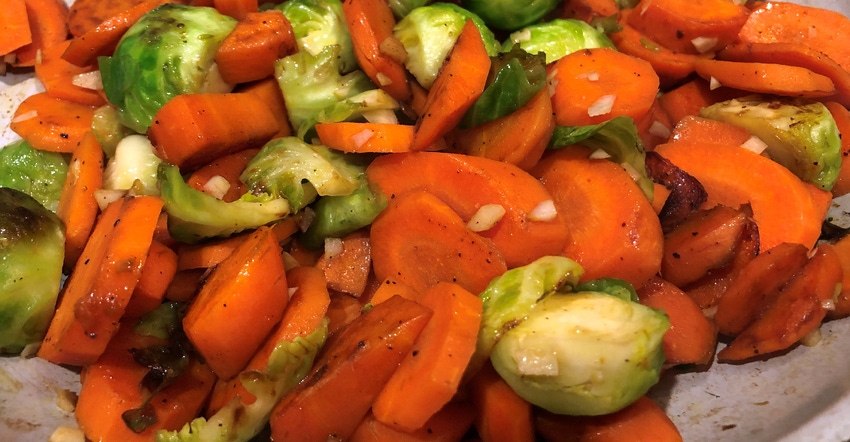January 13, 2021

Looking to be healthier in 2021?
I recommend one simple change. Just one. That’s all.
Eat more vegetables.
That one thing can reduce your risk of heart attack and stroke, protect against certain types of cancer, help you lose weight, and boost your immune system.
Vegetables are simply a powerhouse of vitamins, minerals and fiber, yet they are low in calories. They are especially high in potassium, folate vitamin A and vitamin C. Here’s why those nutrients are so important:
Diets rich in potassium may help to maintain healthy blood pressure. Vegetable sources of potassium include sweet potatoes, white potatoes, white beans, tomato products (paste, sauce and juice), beet greens, soybeans, lima beans, spinach, lentils and kidney beans.
Dietary fiber from vegetables, as part of an overall healthy diet, helps reduce blood cholesterol levels and may lower risk of heart disease. Fiber is important for proper bowel function. It helps reduce constipation and diverticulosis. Fiber-containing foods such as vegetables help provide a feeling of fullness with fewer calories.
Folate (folic acid) helps the body form red blood cells. Women of childbearing age who may become pregnant should consume adequate folate from foods, plus 400 micrograms of synthetic folic acid from fortified foods or supplements. This reduces the risk of neural tube defects, spina bifida and anencephaly during fetal development.
Vitamin A keeps eyes and skin healthy and helps to protect against infections.
Vitamin C helps heal cuts and wounds and keeps teeth and gums healthy. Vitamin C aids in iron absorption.
So why don’t we eat more vegetables? Too hard to cook? Family won’t eat them? I encourage you to keep offering them in attractive, new ways. My husband surprised me by suggesting we add spinach to our pizza. That’s after my conscious efforts (I try not to preach) to add spinach to nearly everything, including our Sunday morning egg bake casserole. All it takes is a little repetition, and eventually that sweet potato becomes a craving.
Roast away
Have you tried roasting veggies? Just place any and all veggies in a 400-degree-F oven for 20 minutes, with a splash of olive oil and dash of salt and pepper. Add some garlic, balsamic vinegar, fresh herbs — whatever you have on hand. Roasting brings out the rich, sweet flavors of vegetables as they caramelize. It works for Brussels sprouts, carrots, broccoli, butternut squash, zucchini, onions — whatever is lingering in your refrigerator. Roast them on a cookie sheet lined with foil for easy cleanup. After 10 minutes, you can lay a chicken breast, piece of salmon or pork chop in the middle and have dinner ready with minimal fuss.
If you prefer the stove, add olive oil to your favorite saute pan, slice carrots in rounds or cut Brussels sprouts in halves, and add garlic and a couple of tablespoons of water for a great side dish to a blackened pork tenderloin.
I’m convinced we’re on this Earth to make a difference, but we can’t fulfill that if we’re not healthy. Skip your list of resolutions this year, and just add vegetables to every meal to get on the road to healthy. (And no, french fries and ketchup are NOT vegetables). Peruse the grocery store for a vegetable you’ve never tried. Try a salad with different lettuce for lunch with your favorite protein on top. Or warm up this winter with a hearty vegetable soup.
Here’s a quick and easy recipe featuring carrots and Brussels sprouts:
Garlic Cilantro Carrots and Brussels Sprouts
4 carrots, peeled and sliced
2 garlic cloves, minced
Salt and pepper
¼ cup water
2 tablespoons cilantro, fresh
4 ounces Brussels sprouts, trimmed and cut in half
2 teaspoons olive oil
In a medium saute pan, add the olive oil and let heat for a minute. Add the sliced carrots and Brussels sprouts. Season with salt and pepper. Stir occasionally until lightly browned, 4 to 5 minutes. Add a quarter cup of water. Cook until water is evaporated and carrots and Brussels are tender, 4 to 5 minutes, continuing to stir. Stir in garlic and cook until aromatic, about 1 minute. Remove from burner and stir in cilantro. Serves 3 to 4.
Fargo is a registered dietitian with Southern Illinois University Medical School in Springfield, Ill. Send recipe ideas to her at [email protected]. The opinions of this writer are not necessarily those of Farm Progress/Informa.
About the Author(s)
You May Also Like






